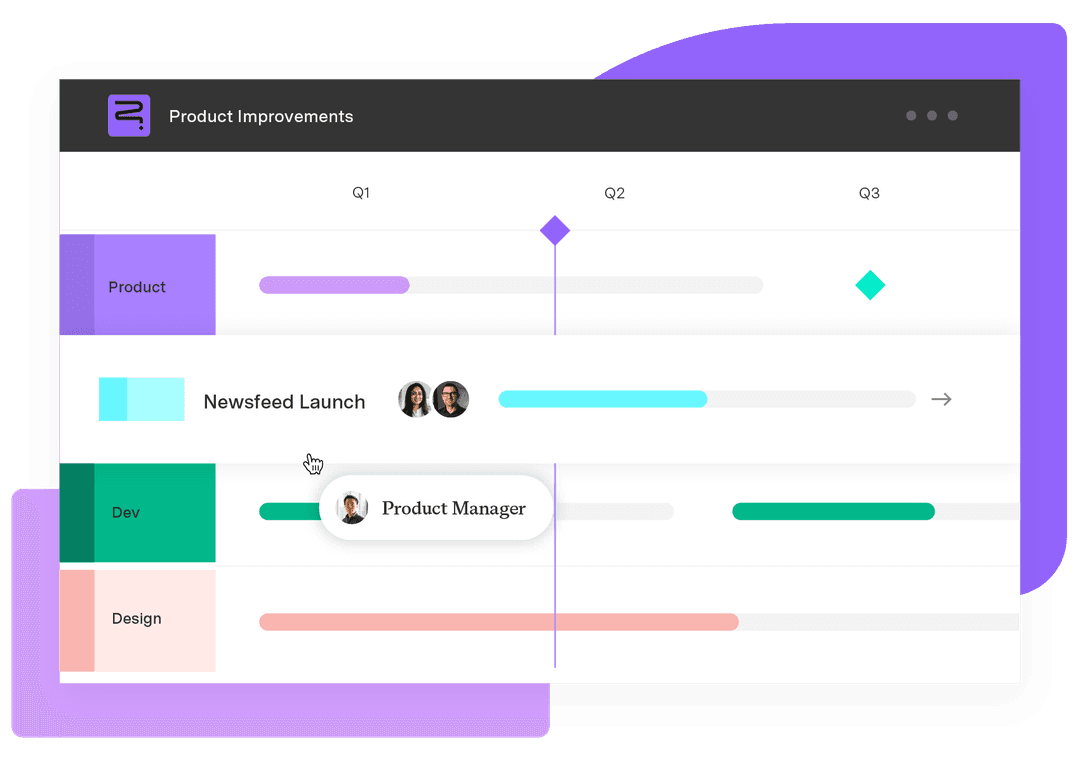Convergent vs. divergent thinking explained
Tempo Team
Some days, you need to think big – really big. You're mapping out bold ideas, considering every “what if” and “why not,” and letting creativity run wild. Other days you need structure and clear answers toward a defined solution.
That balance between exploring ideas and narrowing them down is at the heart of convergent versus divergent thinking. And it’s not just an academic debate – it directly impacts how your team solves problems, makes decisions, and moves projects forward.
Understanding when to diverge and when to converge can make the difference between spinning your wheels and driving real progress. It’s also the foundation of effective brainstorming, strategic planning, and solution-focused execution.
What’s convergent thinking?
Convergent thinking is defined as an action-focused way of solving problems. Instead of exploring every option, you’re working toward the one best answer. It’s a methodical, logical approach that helps cut through the noise to find a clear path forward.
Philosophically, convergent thinking resembles the concept of Occam’s razor, wherein the simplest solution is usually the best. A convergent thinker starts with a question or challenge, considers the options, and then narrows them down to a simple, effective outcome.
This style of thinking is typical in project management and team settings where there’s a clear goal and limited time. It supports decision-making, especially when you need to solve a problem quickly or stay within defined constraints. Convergent thinkers rely on facts, data, and structure.
You’ll often use this mindset during tasks that involve analysis, like choosing between product features, resolving bugs, or planning against tight deadlines. At its core, convergent thinking helps you move from a sea of options to a defined solution that works.
What’s divergent thinking?
Divergent thinking involves exploring a wide range of possibilities without immediately filtering, ranking, or discarding them. The goal isn’t to find the one “right” answer but to unlock as many ideas and potential solutions as possible.
So, what does “divergent” mean in a project management context? Simply put, it refers to thought processes that diverge – branch out – from a single idea into many directions. This kind of thinking fuels innovation and creative problem solving, especially in the early stages of planning or tackling a challenge.
Whether you're working on a new product, content strategy, or team project, tapping into this kind of open-ended thinking can lead to ideas you might never have considered if you started with a more structured approach.
When to use convergent vs. divergent thinking
Understanding when to use convergent versus divergent thinking can be the difference between a scattered project and a successful one. These two types of thinking aren’t opposites – they’re teammates. The real power lies in knowing when to switch from one to the other.
Let’s break it down.
Start with divergent thinking to explore possibilities
At the start of any project – whether you're launching a product or running a brainstorming session – begin with divergent thinking. At this stage, your cognitive process is all about exploring without limits. You’re not chasing a single defined solution yet. Instead, you’re collecting ideas and welcoming unexpected angles.
Divergent thinking helps teams:
Generate fresh concepts
Consider a diverse range of perspectives
Challenge existing logic and routines
Support innovation and progress
This approach is especially useful in early project management phases like ideation and user research, where flexibility matters more than finality. Having a positive mental attitude during this stage can make all the difference. It builds team confidence, encourages contribution from reluctant voices, and helps your team stay open to new possibilities.
Shift to convergence thinking to organize and decide
Once you’ve explored the possibilities, it’s time to shift gears. This is where convergent thinking comes in, giving you a more structured and logical way of evaluating your options and selecting the best one.
At this stage, you're looking for the most effective, viable solution and eliminating distractions. This is when the art of persuasion becomes vital. You’ll need to rally the team around one path, align stakeholders, and explain why this solution wins.
Use convergent thinking when you need to:
Analyze and organize input
Prioritize tasks or features
Align on direction
Make final decisions
This process helps you move forward with clarity and confidence. It’s useful in later phases of project management, when you need to execute with precision and meet deadlines.
Example workflow
Here’s a simplified example of applying both styles in a product cycle:
Discovery (divergent): Host brainstorming sessions, interview users, and explore pain points.
Strategy (convergent): Analyze feedback, filter out weak ideas, and align with business goals.
Design (divergent): Mock up several versions and experiment with layouts or flows.
Delivery (convergent): Choose the best design, prioritize features, finalize and build.
When balanced properly, convergent and divergent thinking create a feedback loop that drives creativity and clarity. So next time you're stuck, ask: Do we need to diverge or converge?
The pros and cons of convergent vs. divergent thinking
Knowing the strengths and limits of both philosophies helps decide when to use each style in your project or product workflow. Both types of thinking are essential, but they work differently.
Here’s a quick comparison to help you understand their benefits and challenges.
Pros of convergent thinking
Convergent thinking is structured, focused, and outcome-driven, making it ideal for the later stages of any project or decision-making process. Here’s what makes it powerful:
Goal-oriented clarity: Helps teams move from confusion to action with a clearly defined solution.
Time-efficient: Reduces overthinking by narrowing down options quickly and logically.
Evidence-based: Encourages critical thinking, logical reasoning, and data analysis.
Aligns with popular project management frameworks: Pairs well with tools like the theory of constraints, OKRs, or product roadmaps.
This problem-solving process is especially effective when validating ideas, prioritizing tasks, or moving from strategy to execution.
Cons of convergent thinking
While convergent thinking can streamline execution, it can also limit scope, especially if used too early in a project. Challenges include:
Creativity constraints: The pressure to find one “correct” answer may discourage risk-taking or outside-the-box thinking.
Can reinforce bias: Teams may converge too quickly around familiar solutions or with the loudest voice in the room.
Overusing this thinking style can result in missed opportunities, especially when the problem hasn’t been fully explored.
Pros of divergent thinking
Divergent thinking is about breaking free from constraints. Here’s what makes it effective:
Boosts creativity: Diverging encourages imaginative solutions, especially when problems don’t have obvious answers. A wide-net approach is great for discovery, experimentation, and rethinking assumptions.
Promotes inclusive collaboration: Exploring multiple paths opens up space for diverse perspectives and input, not just the “right” answer.
Supports ideation stages: Brainstorming works well in early project phases, design sprints, and wireframe sessions.
Divergent thinkers naturally operate in creative settings, which is critical when you're searching for breakthrough ideas.
Cons of divergent thinking
As free-flowing as divergent thinking can be, it needs boundaries to avoid stalling momentum. Possible downsides include:
Too many ideas: Without structure, teams can become overwhelmed by endless possibilities (an experience known as idea fatigue). Lack of filtering or prioritization can lead to indecision and eventually stagnation.
Not ideal for urgent decisions: Divergence doesn’t provide a clear endpoint, which can be frustrating when deadlines loom.
Divergence is just one part of the creative equation – you need convergence to land the plane. In Agile environments, this often looks like starting a sprint with a divergent mindset (ideation, sketching, prototyping), followed by a convergent approach (prioritizing, refining, shipping).
Comparing convergent vs. divergent thinking
Now that you know the differences between convergent and divergent thinking, let’s summarize and compare their main attributes.
The basics | Convergent thinking | Divergent thinking |
Definition | Structured, logical problem solving that narrows options into a single best answer | Creative, exploratory thought process that generates multiple ideas and solutions |
Approach | Organized, linear, and focused on evaluation and decision-making | Open-ended, spontaneous, and focused on exploration and ideation |
Goal | Find the most effective or logical solution | Explore as many possibilities and perspectives as possible |
Best used for | Later stages: refining, prioritizing, and executing | Early stages: brainstorming sessions, discovery, and innovation |
Typical outcome | A defined solution that can be implemented | A wide pool of unfiltered ideas or directions |
Used by | Convergent thinkers such as analysts, engineers, and decision-makers | Divergent thinkers such as designers, creatives, and ideators |
Connect creative and strategic thinking with Tempo
The best ideas come from exploring many possibilities, and the best results come from acting on the right ones. With Tempo, your team doesn’t have to pick between creativity and clarity: You get both.
Use Idea Manager to capture a wide range of inputs – from off-the-cuff thoughts during brainstorming sessions to strategic feedback across your organization. Then, shift seamlessly into action with Strategic Roadmaps, where you can prioritize, align, and plan with precision.
Whether you’re generating bold ideas or narrowing down to a defined solution, Tempo supports every step of your problem-solving process.
Try Tempo today and bring structure to your ideation and momentum to your decision making.












































